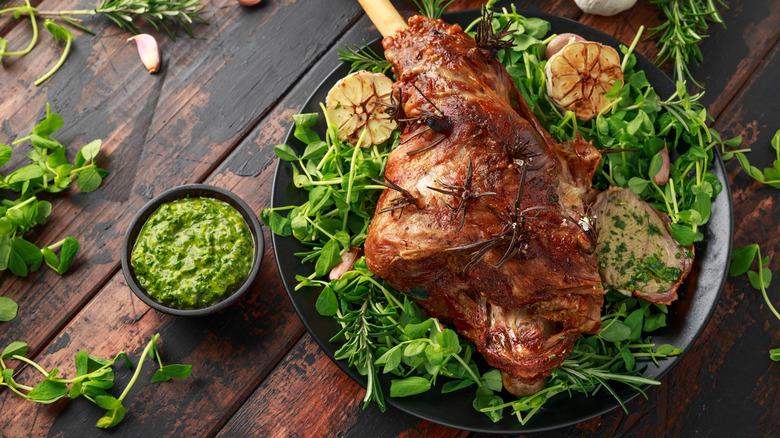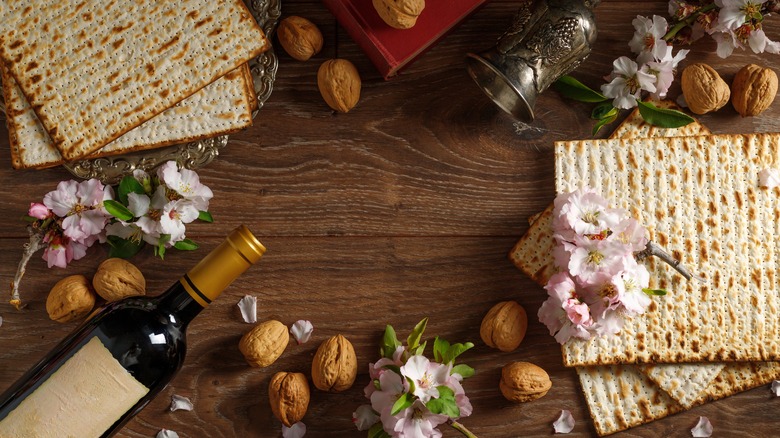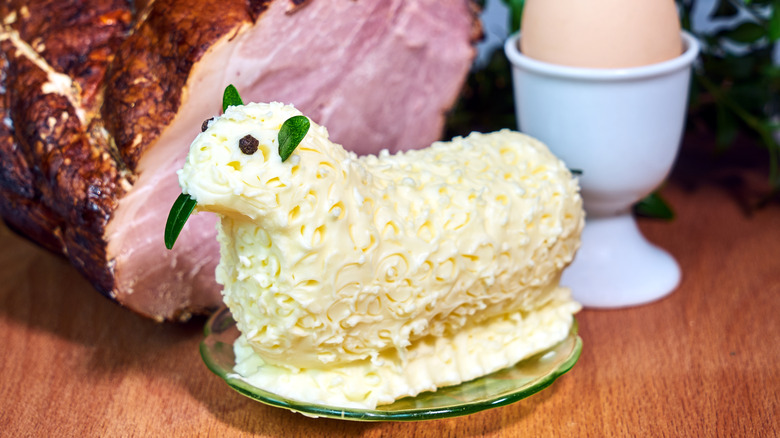Why Lamb Is A Classic Part Of The Easter Dinner Table
Spring is right around the corner, meaning, of course, that Easter is also coming up. Chocolate bunnies and colored eggs are part of the experience. And don't forget about the often polarizing marshmallow Peeps. However, it's never a good idea to fill up on candy goodies early in the day for fear you may not be able to fully appreciate the best part of Easter — the feast.
Just like Thanksgiving dinner wouldn't be the same without a roasted turkey and Christmas wouldn't feel right without some prime rib, Easter dinner wouldn't be the same to many without eating a beautifully cooked lamb. The custom of eating lamb on Easter goes back centuries. For Christians, the lamb is representative of Jesus — the "Lamb of God" — sacrificing himself to be crucified.
Jesus is often referenced in Christianity as the Paschal lamb. The term "pascha" is an Aramaic word that refers to items involved in Passover, like the paschal sacrifice. In Christianity, Jesus is considered a lion-like lamb. Lamb-like innocence coupled with the strength and bravery of the lion is meant to symbolize Jesus' designation as both victim and victor in Christianity. When Jesus met his disciples for Passover in Jerusalem, he told them he was the Paschal lamb. Christians continue to eat lamb on Easter in honor of Jesus' ultimate sacrifice — his life. But the ritual of eating lamb for Easter has even deeper roots.
Lamb for Easter began with Passover traditions
Before Christianity, lambs were sacrificed during the Jewish Passover, also known as paschal sacrifices. Passover honors the ancient Jewish people's exodus from Egypt, and memorializes the story of how "the angel of death" spared the firstborn sons of those who had smeared the blood of a sacrificial lamb on their doors. To this day, the lamb still plays a role in Passover Seders.
Christians continued to celebrate Passover early on, not seeing any reason to create a new holiday to celebrate the resurrection of Jesus. Eventually, Christians began honoring Passover in their own way, which is now called Easter. By the 9th century, Rome had adopted the routine of blessing lambs for feasts, and, for centuries, the main feature of the Pope's Easter dinner was roasted lamb. Easter celebrations have continued to evolve with additional customs since, with some even tossing aside the established practice of cooking a lamb for an often more affordable option.
Modern twists on Easter dinner
One Easter custom that sprang up over time was creating a butter lamb for the occasion. This isn't just a roasted cut of lamb encrusted in butter, but a miniature sculpture of a lamb, made of butter. This charming concept originated with Eastern Europeans and Polish Catholic immigrants who introduced the idea to Americans. Today, many can't call their Easter banquet complete without a cute little butter lamb resting on the table.
Though some continue the tradition of feasting on lamb for Easter, it's not uncommon to see some celebrate the religious holiday slightly differently. Ham is often the centerpiece of Easter for many Christian families in the U.S. This modern take on Easter dinner is a recent change historically. By the late 19th century, some Christians had begun to swap lamb for pork. European Christians started adopting the practice in part to differentiate them from other religions, like Judaism and Islam, which are forbidden to eat pork. Later on in the 1950s, ham also became the more affordable option for an Easter centerpiece.
Like many other holidays, Easter is a day when those who observe it eat their fill of sweet treats and delicious meats. If you're like many and you prefer a succulent ham for the big celebration, keep the butter lamb in mind as another component to place on the table. Making one is fun for adults and children alike, and it's an adorable way to celebrate Easter with a Paschal lamb.


